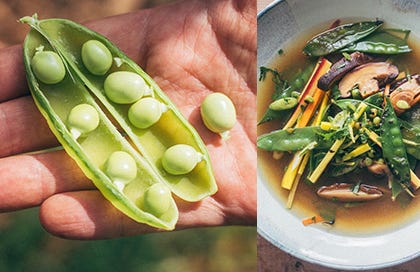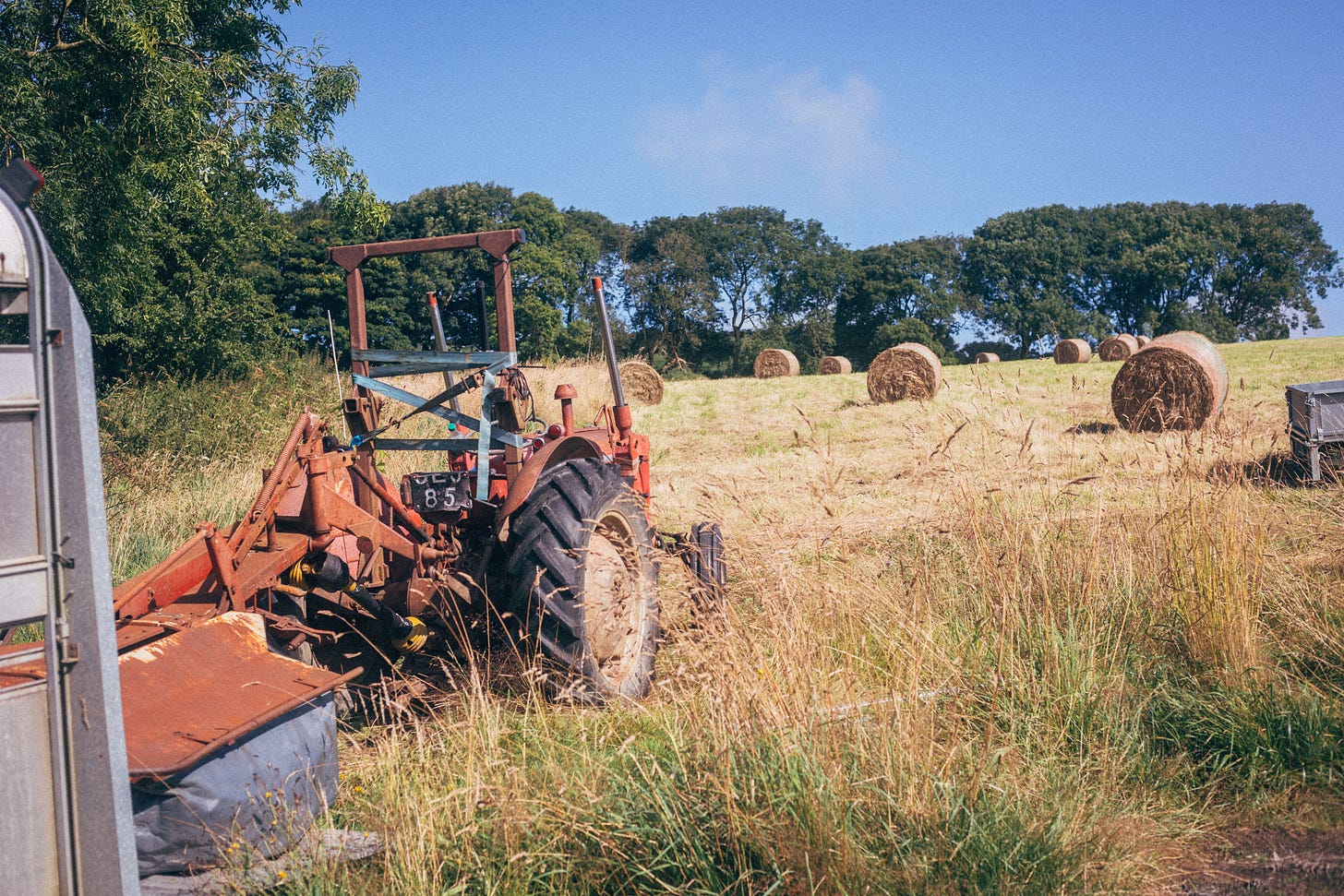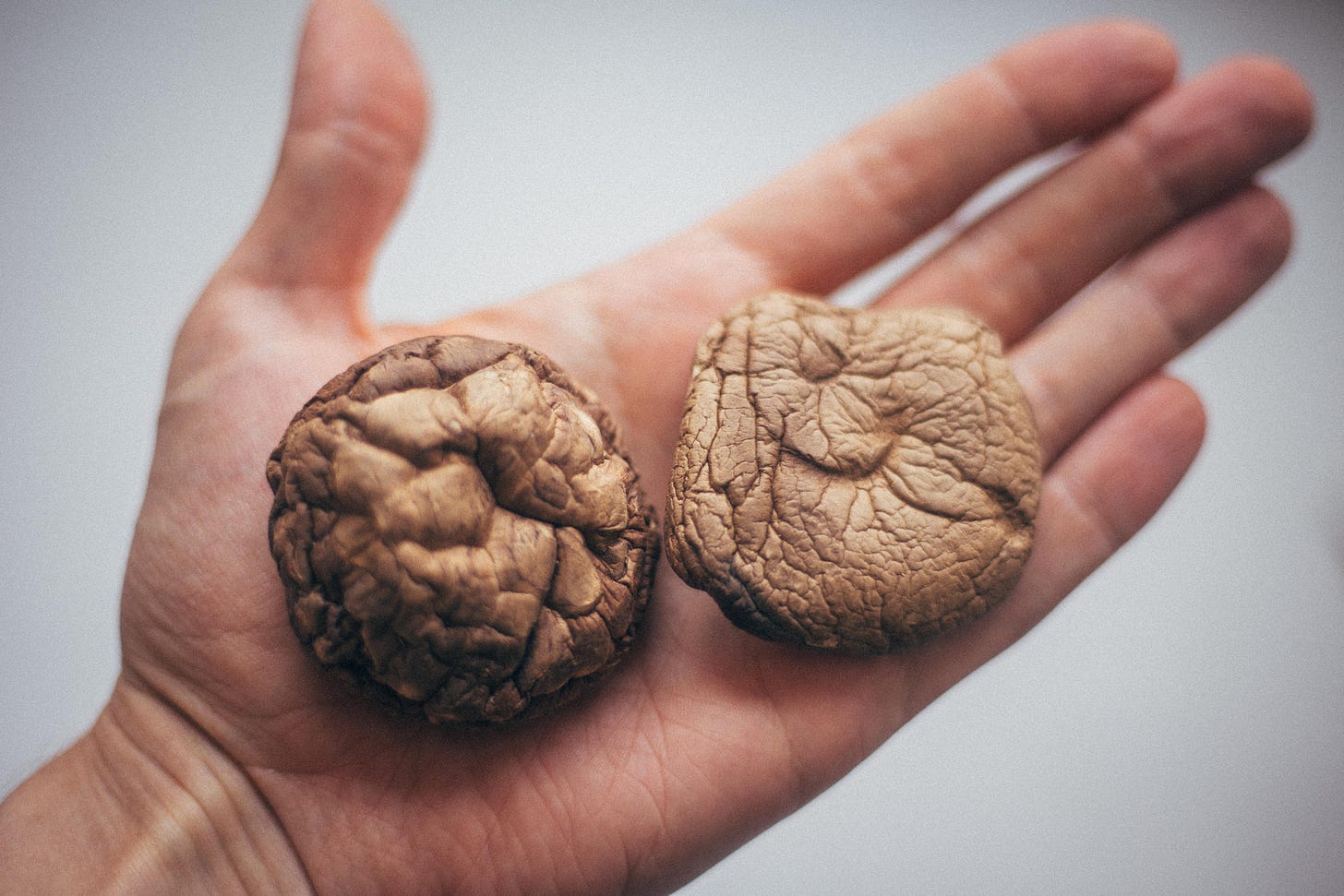From a Farm in Wales | A Very Special Pea | Mushroom and Pea Miso Broth #3
Diary of free ranged chef
In this week’s newsletter I thought I’d share more on the wonderful pea, a recipe using fresh peas and fermented peaso (miso made from peas), growing heritage and heirloom varieties in your garden, and a welcome to my home, along with a few key memories that capture the heart of what I love about producing and eating good food here. And where better to start than the country I call home. Let my welcome you to Wales, the lesser known member of the United Kingdom.
If you aren’t familiar with the country, let me briefly introduce you. Wales is one of the remaining lands of the Celts, where the native Celtic population of Britain weathered the invasions of Romans, Anglo Saxons, and Vikings alike. Even the word ‘Welsh’ comes from Anglo Saxon and means ‘foreigner’. The Welsh word for themselves is Cymro and is thought to derive from an earlier Brittonic word, combrogos, meaning 'compatriot' or 'a fellow-countryman'.
This fair land is known for being the home of Ryan Reynolds’ football team, a source of inspiration for more than one of legendary director, Hayao Miyazaki’s world famous animations, who remarked on the people, culture, history, and ancient religion of the land as sharing many values with what he saw to be distinctly Japanese, as well as a huge influence on J.R.R.Tolkien’s creation of the Elvish language, Sindarin; Tolkien himself describing Welsh as “The senior language of the men of Britain.” Which in Welsh is said “Yr iaith uwch y dynion o Brydain.”
Yes, it’s basically a magical, mythical land of fairytales and farmers with a dragon on its flag. Yet somehow the Eurocrats missed it out altogether on the cover of the Eurostat Statistical Compendium back in 2004. See the images below. Oops.
With introductions out of the way, this sometimes forgotten corner of the world is where you can find our small farm, nestled in a valley beside the sea on the west coast of Wales. Growing food here is a challenge, and one that has shaped the cuisine of the country through the ages. One of the reasons the Welsh were able to hold on to their way of life in this corner of Britain is because of the mountains, forming a naturally defensible border to England, as well as unfavourable living conditions. Now I’m not saying the Saxons didn’t want Wales, but compared to England, there is very little arable land, with only 6% of it being suitable for growing crops. Combined with crazy rainfall, late frosts, and year round cloudy weather, it’s no surprise that Welsh food became famous for lamb, The Welsh Black Cattle, and in recent years, the reintroduced wild boar, which was previously hunted to extinction. This led to a cuisine of meaty stews, cheeses, bakes and biscuits, dense fruity cakes, cockles, muscles, fish, and seaweed. A food culture seemingly designed with one simple goal, to keep you warm and comfortable.
Now, I grew up in Shropshire, placing me firmly on the Anglo Saxon side of history. Growing up, I remember vivid golden fields of rapeseed flowers swaying in the breeze and the smell of the sugar beet factory processing crops grown on the surrounding land. Vast rolling fields, winding rivers, pockets of old towns and urban housing estates, and in the distance, the rising craggy shadows of the beautiful bleak Welsh mountains, scarred by dry stone walls used to control the rotation of grazing animals.
There are, of course, crops that grow here in Wales too. Often incredibly durant, hardy landrace varieties such as Dyfed Black Oats, rye, and Hen Gymro, a tall wheat variety that’s particularly tolerant of heavy rain and prized for its length of stem, which meant the crop doubled up as a food as well as a housing material for thatched roofs. But trends over the last 100 years for southern foods, such as pillowy white breads, which require wheat with a high gluten content, meant such vital crops fell out of favour and nearly went extinct. If you’re interested in tasting the world of regional crops over Britain, and the age-old recipes associated with them, I recommend checking out the book ‘Oats in the North, Wheat from the South.’ by Regula Ysewijn.
In the last few weeks we’ve seen the tomatoes turning colour, a few onion harvests, squash taking over every inch of pathway, berries and fruit ripening in the hedgerows, and the field baled.
If you’re interested to know more about how we grow food, the types of crops we grow, and how we manage the space with just three people, no power, and no mains water, let me know and I’ll happily share more. What we do is a hybrid of permaculture gardening, farming, regeneration, with wild corners, so there’s a lot that can be applied to home gardening setups.
Chef’s Almanac - June to October
A Very Special Pea
Stepping foot into the polycrub, a type of stormproof polytunnel from Shetland, I was confronted by a monolithic green trifid. It towered over me with delicate white flowers, reaching tendrils, and the vibrating hum of bees. Back then, I had never grown peas before, having recently left cheffing to start work with my friend Huw. Huw, who had grown peas every year since before he could walk (both of which he’s now quite good at), was excitedly hopping around this sprawling mass of jungle. As it turned out, this particular pea was also new for him, and neither of us had quite anticipated its sheer size and wild nature.
Reaching between the stems, Huw tugged a handful of fat, abundant green pods from the heart of the trifid. From my time in kitchens, I’ve come across many a pea in all shapes and sizes. Freshly harvested, dried, frozen, podded, shelled, shoots, you name it. But I’d never seen pods like these before. Larger than chickpeas or field beans, in vivid green, hard pods that audibly cracked as we prized them open to reveal the fattest peas I’d ever seen. Huw and I shared a look. We both knew, from past experience, that large peas usually have no flavour, as the sugars turn to starch with time. Had we let them grow on for too long? Oh well, we ate them anyway.
This is how I was introduced to the Llanover pea, a Welsh heirloom variety that appeared in this country shortly after the Second World War, having hitched a ride in a soldier’s pocket as he returned home from Europe to marry his childhood sweetheart. And every time I’ve eaten this pea since, that deliciously refreshing pop of sunkissed sweetness brings this memory flooding back and before I know it, I’m stood in the polycrub again, holding an empty pod in my hand, watching an expression of shock and ecstasy spread across Huw’s face.
They were incredible. But how? How could they be so tasty when they were clearly too big? We reached for more, finding yet larger pods and cracking them open eagerly. These too were delicious. Incredibly sweet, with subtle umami that provided contrast and depth, rounding off the flavour in a way I’d never experienced before.
Peas are thought to be one of the earliest cultivated crops in human history and have played a key role in both agriculture as well as our understanding of genetics. Through the work of Austrian monk Gregor Mendel, who furthered our understanding of genetics through his experiments in cross-pollinating pea plants with different features, most famously, purple flowers and white, the colour of their corresponding seeds, and mathematical formula that explained the frequency of each as dominant and recessive traits. Over 150 years later, in 2022, the actual genetic factors observed by Mendel were isolated and defined, proving him right.
Since getting into growing food, I’ve become mildly obsessed with heirloom and heritage varieties, as well as their wild counterparts and ancestors. Experiencing the plethora of flavours, textures, and aroma of different varieties of apples, observing their pollination habits and root stock, heritage wheat and oats like Hen Gymro and exploring how they require a wholly different set of skills to handle in the kitchen, often reflecting the vintage of their harvest with an expression of completely different flavours and fragrances, and of course peas, notably the Llanover.
To some, these old crops might seem tricky, a little redundant or clunky. When compared to the slick, efficient machine of modern industrial agriculture, it’s easy to see these unrefined, slightly wild relatives of domesticated crops as a gimmick, or worse, unnecessary. But these crops carry genetic traits that offer key adaptations and advantages, as well as safeguards against diseases and pests that could wipe out a genetically homogenous crop. Traits that appeared through a combination of happenstance (we call evolution) and selection by the generations of people who grew them. This selection process took thousands of years, and was often motivated by abundance, resistance, hardiness, and flavour, because without modern science as guidance on nutrition, flavour was the main way to determine the nutrients of a crop (along with burning it to determine its mineral content by ash). This process is what we call landrace, and until recent years, it was our only way to cultivate new crops. And whatever you think the future of food production might look like, without preserving the best of the past, we have no future.
The most fun part is you can grow heirloom peas yourself, in your own garden or backyard. Peas are one of the easiest crops to grow and save seed from; they’re fast, relatively hands off, reliable, and climb upwards (so they don’t require a lot of ground). And unlike other plants, they have no rules around how many you need, or the dangers of cross-pollination with poisonous wild relatives. Arguably, you only need one pea plant in order to save seed, but I’d suggest growing a few more at least so you have plenty to eat, as well as a little genetic diversity.
To save seed, towards the end of the growing season, leave some pods on the plant to harden and mature, which will take between one and four weeks. Pick them from the plants and leave them out to dry in a bowl or over a wire rack. When papery dry and yellow, crack them open and remove the peas, and leave them out a few more days to make sure the individual peas are nice and dry. Once they are, shake them out in a sieve to remove the chaff (the litter from the pods) and store them in a jar, bag, or envelope for the following season. Over years of doing this, you may even notice certain characteristics develop that you can cultivate by selecting only the largest peas or peas from a plant that grew particularly quickly, or seemed extra tasty, or bounced back particularly well after heavy rainfall. By doing so, you’re also taking part in the landrace, and developing an entirely new variety that’s highly localised to you.
Mushroom and Pea Broth
A very simple soup, made well
This combination of allium, miso, and mushrooms forms my go-to base for any quick, simple, vegetable broth. The nuttiness of shiitake mushrooms with sweet and umami amino flavours compliments vegetables without overpowering them. I use homemade peaso, but if you haven’t made your own (more on that next week), you can substitute this with any white / shiro miso. This recipe is refreshing, sweet, complex, and umami. And whilst it’s at its best with fresh garden peas, you can of course use frozen and it’ll still be delicious. If you’d like to experience the flavour of fresh without the faff of podding, I suggest using sugar snap peas or mangetout.
Serves 2
Takes 20 minutes
350g peas (a mixture)
150g dried shiitake*
2 garlic cloves, thinly sliced
1tsp white miso
20ml white wine
2 small carrots, julienne
2 spring onions, finely chopped
Half a lemon, zest
A small bunch of fresh parsley
* You can use any mushrooms you have, or mix and match dried and fresh.
Soak the dried shiitake in 600ml cold water for 5-24 hours. It’s important to keep the water around 5°C (41°F) to preserve the umami, as warmer temperatures cause it to break down.
Whilst you wait, pick and pod the peas.
When they’re soaked, remove the mushrooms from the tea and wring out the excess water. Remove the stems from the caps and cut the caps into thin slices. Shred the stems, which are usually tougher, then add the whole lot into a pan over a high heat, tossing them every so often.
After 5 minutes, when the mushrooms have a little colour on them and release their aroma. Add the peas, keeping the heat high, and cook for another 5 minutes, tossing once or twice to avoid over charring.
Add the white wine and mushroom tea to deglaze the pan (avoid adding the sediment/grit from the bottom of the tea), then lower the heat and add the garlic, lemon zest, and carrots. Cook for another 2 minutes, then remove from the heat and add the miso, spring onion and chopped parsley.
Adjust the seasoning to taste and serve right away, whilst the carrots still hold a bit of crunch.
The next newsletter we’ll cover all things miso, how to make your own from any and all beans and peas, a breakdown of fresh vs premade rice koji, and an experiment that left me with one half of an immortal bread roll.
If this sounds like your cup of tea and you aren’t subscribed to my newsletter, please consider subscribing with the button below. I never lock content behind a paywall and only reserve direct messages and the full recipe archive for paid members. Free members get access to all newsletters and recipes that are less than 3 months old, so sign up now.












Thank you Sam for a wonderful description of the land I love. I, for one, would be interested to hear more about the farm. In my youth I dreamed of farming in mid-Wales but life took me in another direction. Now I encourage my grandchildren to grow fruit and vegetables.
Your take on food is inspiring.
A beautiful meander through Welsh history, and even though we cannot grow peas; they always fail no matter what we do, I've noted your glorious sounding pea for next year.